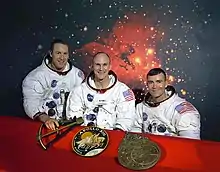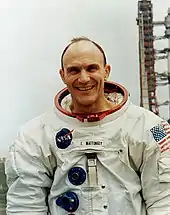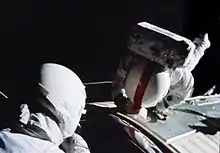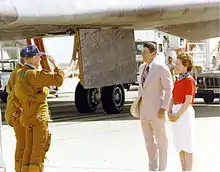Ken Mattingly
RADM Thomas Kenneth Mattingly II, USN, Ret. (born March 17, 1936) is a former American aviator, aeronautical engineer, test pilot, Rear Admiral in the United States Navy and astronaut who flew on the Apollo 16, STS-4 and STS-51-C missions.
T. Kenneth Mattingly II | |
|---|---|
_Mattingly.jpg.webp) | |
| Born | Thomas Kenneth Mattingly II March 17, 1936 Chicago, Illinois, U.S. |
| Status | Retired |
| Nationality | American |
| Other names | Ken Mattingly |
| Alma mater | Auburn University, B.S. 1958 |
| Occupation | Naval aviator, test pilot |
| Awards | |
| Space career | |
| NASA Astronaut | |
| Rank | |
Time in space | 21d 04h 34m |
| Selection | 1966 NASA Group 5 |
Total EVAs | 1 |
Total EVA time | 1 hour 23 minutes |
| Missions | Apollo 16, STS-4, STS-51-C |
Mission insignia | |
| Retirement | June 1985 |
Mattingly had been scheduled to fly on Apollo 13, but three days prior to launch, he was held back and removed from the mission due to exposure to German measles (which he did not contract). He later flew as Command Module Pilot for Apollo 16 and made 64 lunar orbits,[1] making him one of 24 people to have flown to the Moon.[2] Mattingly and his commander from Apollo 16, John Young, are the only people to have flown to the Moon and also a Space Shuttle orbital mission (Fred Haise, his former training crewmate from Apollo 13, did atmospheric flight testing of the Space Shuttle "Approach and Landing Tests").
During Apollo 16's return flight to Earth, Mattingly performed an extravehicular activity (EVA) to retrieve film cassettes from the exterior of the spacecraft, the command and service module. It was the second "deep space" EVA in history, at great distance from any planetary body. As of 2021, it remains one of only three such EVAs which have taken place, all during the Apollo program's J-missions.[3]
Early life and education
Thomas Kenneth Mattingly II was born on March 17, 1936, in Chicago, Illinois, to Thomas Kenneth Mattingly and Constance Mason (née Clarke) Mattingly.[4][5] His father, who had been hired by Eastern Airlines soon after his son's birth, moved the family to Hialeah, Florida. Aviation became part of Mattingly's life from a very young age; he later recalled that his "earliest memories ... all had to do with airplanes."[6]
Mattingly was active in the Boy Scouts of America where he achieved its second highest rank, Life Scout. He graduated from Miami Edison High School in 1954, and went on to receive a Bachelor of Aeronautical Engineering degree from Auburn University in 1958.[6] He was also a member of Delta Tau Delta fraternity (Epsilon Alpha chapter).[7]
Military career
He joined the U.S. Navy as an Ensign in 1958 and received his aviator wings in 1960. He was then assigned to Attack Squadron Thirty-five (VA-35) at Naval Air Station Oceana, Virginia and flew A-1H Skyraider aircraft aboard the aircraft carrier USS Saratoga from 1960 to 1963. In July 1963, he served in Heavy Attack Squadron Eleven (VAH-11) at Naval Air Station Sanford, Florida, where he flew the A-3B Skywarrior aircraft for two years and deployed aboard USS Franklin D. Roosevelt.[2] While based at Sanford, Mattingly's friend and fellow officer was assigned to a undertake aerial photo reconnaissance of a launch from Cape Canaveral and he convinced Mattingly to accompany him to on this mission and they ended up observing the launch of the Gemini 3 (carrying Mattingly's future Apollo 16 Commander John Young) from the air.[8] After finishing his second cruise, Mattingly was frustrated in his attempt to join the US Navy Test pilot school at Patuxent River since the said cruise ended after the start of the class, however, he managed to obtain a place in the USAF Test Pilot School at Edwards Airforce Base[9] where future astronauts Edgar Mitchell and Karol J. Bobko were his classmates and instructors included Charles Duke, his Apollo 16 crewmate and Henry Hartsfield who Mattingly would command on STS 4.
He has logged 7,200 hours of flight time—which includes 5,000 hours in jet aircraft.[2]
NASA career

Selection and training
On September 10, 1965, NASA began the selection process for the fifth astronaut group. From a pool of 351 applicants, NASA selected 159 candidates that met the basic qualifications that required that applicants must be United States citizens born on or after December 1, 1929, and no more than six feet tall. They were also required to have at least 1,000 hours of flight time in a jet aircraft. Mattingly had previously shown little interest and inclination to apply for the astronaut program, however, his views changed when at the Air Force Test Pilot School and his class was offered the chance to apply for either NASA or the USAF Manned Orbiting Laboratory program. Mattingly and Mitchell chose the latter and were rejected. The deadline for applying for the NASA group had passed however one of their instructors was able to get NASA to accept their application regardless.[10] On the interview panel the astronaut office representatives were John Young and Michael Collins, at that time in training as prime crew for Gemini 10. Mattingly would later recollect that he was "perplexed" by Young. Collins asked Mattingly what he felt about the F-104, to which Mattingly replied that he thought it was a "fun aircraft" but without worth in combat, Collins appeared to dislike the answer and Mattingly felt he had blown his chance. However, after the conclusion of the selection process, Mattingly was called by Deke Slayton with an offer to become an astronaut.[11]
At the time of his selection, had 2,582 hours of flight experience, including 1,036 hours in a jet aircraft. He also had a bachelor's degree in engineering or in the physical or biological sciences as required by the initial qualifications. From the 100 military personnel and 59 civilian candidates, NASA selected 19 astronauts to join the group.[12]
Mattingly, a lieutenant in the U.S. Navy,[12] was a student at the Air Force Aerospace Research Pilot School at Edwards AFB, California, when NASA selected him as an astronaut in April 1966.[2][13]
Apollo 8 and Apollo 11

At first, Mattingly was part of the support crew for Apollo 8. Mattingly served as CAPCOM during Apollo 8's second television transmission and subsequent preparation for trans-Earth injection.[14]
He then trained parallel with Bill Anders for Apollo 11 as backup Command Module Pilot, because Anders was going to retire from NASA in August 1969, and in case of mission delay, Anders would be unavailable.
Apollo 13
Mattingly's first prime assignment was to be the Command Module Pilot on the Apollo 13 mission. Three days prior to launch, he was removed from the mission due to exposure to German measles (which he never contracted) and was replaced by the backup CM pilot, Jack Swigert.[15] As a result, he missed the dramatic in-flight explosion that crippled the spacecraft.[16] However, Mattingly had a large role in helping the crew solve the problem of power conservation during re-entry.[15][17]
Apollo 16

The swapout from Apollo 13 placed Mattingly on the crew that would fly Apollo 16 (April 16–27, 1972), the fifth crewed lunar landing mission. The crew included John W. Young (Commander), Mattingly (Command Module Pilot), and Charles M. Duke Jr. (Lunar Module Pilot). The mission assigned to Apollo 16 was to collect samples from the lunar highlands near the crater Descartes. While in lunar orbit the scientific instruments aboard the Command/Service Module Casper extended the photographic and geochemical mapping of a belt around the lunar equator. Twenty-six separate scientific experiments were conducted both in lunar orbit and during cislunar coast. Major emphasis was placed on using man as an orbital observer, capitalizing on the human eye's unique capabilities and man's inherent curiosity.[2]
During the return leg of the mission, Mattingly carried out an extravehicular activity (EVA) to retrieve film and data packages from the science bay on the side of the service module. Although the mission of Apollo 16 was terminated one day early, due to concern over several spacecraft malfunctions, all major objectives were accomplished through the ceaseless efforts of the mission support team and were made possible by the most rigorous preflight planning yet associated with an Apollo mission.[2]
Space Shuttle flights
Following his return to Earth, Mattingly served in astronaut managerial positions in the Space Shuttle development program.[2]


Mattingly was named to command STS-4, the fourth and final orbital test flight of the Space Shuttle Columbia, launched from Kennedy Space Center, Florida, on June 27, 1982, with Henry W. Hartsfield Jr., as the pilot. This 7-day mission was designed to further verify ascent and entry phases of shuttle missions; perform continued studies of the effects of long-term thermal extremes on the orbiter subsystems; and conduct a survey of orbiter-induced contamination on the orbiter payload bay. Additionally, the crew operated several scientific experiments located in the orbiter's cabin and in the payload bay. These experiments included the Continuous Flow Electrophoresis System experiment designed to investigate the separation of biological materials in a fluid according to their surface electrical charge.[2][19] This experiment was a pathfinder for the first commercial venture to capitalize on the unique characteristics of space. The crew is also credited with effecting an in-flight repair which enabled them to activate the first operational "Getaway Special" (composed of nine experiments that ranged from algae and duckweed growth in space to fruit fly and brine shrimp genetic studies). STS-4 completed 112 orbits of the Earth before landing on a concrete runway at Edwards Air Force Base, California, on July 4, 1982.[2] Mattingly and Hartsfield were greeted by President Ronald Reagan after the landing; Reagan recognized the pair, both graduates of Auburn University, as "you two sons of Auburn" in his welcoming speech.[20]
STS-51-C, the first Space Shuttle Department of Defense mission, launched from Kennedy Space Center, Florida on January 24, 1985. The crew included Ken Mattingly (spacecraft commander), Loren Shriver (pilot), James Buchli and Ellison Onizuka (Mission Specialists), and Gary Payton (DOD Payload Specialist). STS-51-C performed its DOD mission which included deployment of a modified Inertial Upper Stage (IUS) vehicle from the Space Shuttle Discovery. Landing occurred on January 27, 1985.[2]
Post-NASA career
In 1985, Mattingly retired from NASA and retired from the Navy in 1986 with the two-star rank of Rear admiral (upper half), and entered the private sector.[21] He worked as a Director in Grumman's Space Station Support Division. He then headed the Atlas booster program for General Dynamics in San Diego, California. At Lockheed Martin he was Vice President in charge of the X-33 development program. He is currently working at Systems Planning and Analysis in Virginia.[22]
Mattingly is a member of many organizations. He is an associate fellow, American Institute of Aeronautics and Astronautics; fellow, American Astronautical Society; and member, Society of Experimental Test Pilots, and the U.S. Naval Institute.[2]
Awards and honors
Mattingly is a recipient of numerous awards. He was awarded the NASA Distinguished Service Medals[23] (2); Johnson Space Center Certificate of Commendation (1970); JSC Group Achievement Award (1972); Navy Distinguished Service Medal; Navy Astronaut Wings; SETP Ivan C. Kincheloe Award (1972); Delta Tau Delta Achievement Award (1972); Auburn Alumni Engineers Council Outstanding Achievement Award (1972); AAS Flight Achievement Award for 1972; AIAA Haley Astronautics Award for 1973; Fédération Aéronautique Internationale awarded him the V. M. Komarov Diploma in 1973; Department of Defense Distinguished Service Medal (1982).[2]
Mattingly was inducted with a group of Apollo astronauts into the International Space Hall of Fame in 1983.[24] He was one of 24 Apollo astronauts who were inducted into the U.S. Astronaut Hall of Fame in 1997.[25]
In media
Mattingly was portrayed in the 1995 movie Apollo 13 by fellow Chicagoan Gary Sinise. He was portrayed in the 1998 HBO miniseries From the Earth to the Moon by Željko Ivanek.[27]
See also
References
- NASA Apollo 16 summary page
- "Astronaut Bio: Thomas K. Mattingly II". National Aeronautics and Space Administration. January 1987. Retrieved April 6, 2012.
- LePage, Andrew (December 17, 2017). "A History of Deep Space EVAs". Drew Ex Machina.
- "Mattingly, Thomas Kenneth, II". Naval History and Heritage Command. May 5, 1972. Retrieved December 15, 2019.
- "Thomas Kenneth Mattingly: Illinois, Cook County, Birth Certificates, 1871-1940". FamilySearch. Retrieved December 15, 2019.
- Shayler, David J.; Burgess, Colin (June 19, 2017). The Last of NASA's Original Pilot Astronauts: Expanding the Space Frontier in the Late Sixties. Springer. pp. 53–54. ISBN 978-3-319-51014-9.
- "Famous Delts". Delta Tau Delta. Archived from the original on May 15, 2010. Retrieved August 19, 2010. Retrieved February 19, 2012
- https://historycollection.jsc.nasa.gov/JSCHistoryPortal/history/oral_histories/MattinglyTK/MattinglyTK_11-6-01.htm
- https://historycollection.jsc.nasa.gov/JSCHistoryPortal/history/oral_histories/MattinglyTK/MattinglyTK_11-6-01.htm
- https://historycollection.jsc.nasa.gov/JSCHistoryPortal/history/oral_histories/MattinglyTK/MattinglyTK_11-6-01.htm
- https://historycollection.jsc.nasa.gov/JSCHistoryPortal/history/oral_histories/MattinglyTK/MattinglyTK_11-6-01.htm
- "Newly-Selected Group of 19 Astronauts Reports Next Month for Duty" (PDF). Space News Roundup. April 15, 1966. pp. 4–5. Archived from the original (PDF) on April 13, 2009. Retrieved December 9, 2019.
- Thompson, Ronald (April 5, 1966). "19 New Spacemen Are Named". The High Point Enterprise. High Point, North Carolina. p. 2A – via Newspapers.com.
- Lovell & Kluger 1994, p. 54.
- Rensberger, Boyce (April 17, 1972). "Thomas Kenneth Mattingly 2d". The New York Times. p. 24. Retrieved December 10, 2019.
- "Biographical Data: John L. Swigert, Jr., NASA astronaut (deceased)" (PDF). Lyndon B. Johnson Space Center. NASA. January 1983. Retrieved December 9, 2019.
- Lovell, Jim; Kluger, Jeffrey (1994). Apollo 13. Boston: Houghton Mifflin. p. 287. ISBN 978-0-618-61958-0.
- "Independence Day at NASA Dryden - 30 Years Ago". NASA. July 3, 2012. Retrieved November 11, 2017.
- Snyder, Robert S.; Rhodes, Percy H.; Miller, Teresa Y. (1987). "Continuous Flow Electrophoresis System Experiments on Shuttle Flights STS-6 and STS-7" (PDF). NASA. Technical Paper 2778. Cite journal requires
|journal=(help) - "Remarks at Edwards Air Force Base, California, on Completion of the Fourth Mission of the Space Shuttle Columbia". Ronald Reagan Presidential Library and Museum. Retrieved January 20, 2018.
- "International Space Hall of Fame: Thomas K. Mattingly II". New Mexico Museum of Space History. 2005. Retrieved July 17, 2013.
- "Great Places to Work: Honorable Mentions". Retrieved August 21, 2007.
- "National Aeronautics and Space Administration Honor Awards". Retrieved March 24, 2012.
- Sheppard, David (October 2, 1983). "Space Hall Inducts 14 Apollo Program Astronauts". El Paso Times. El Paso, Texas. p. 18 – via Newspapers.com.
- Meyer, Marilyn (October 2, 1997). "Ceremony to Honor Astronauts". Florida Today. Cocoa, Florida. p. 2B – via Newspapers.com.
- Hero, Basil (April 2, 2019). The Mission of a Lifetime: Lessons from the Men Who Went to the Moon. Grand Central Publishing. p. 243. ISBN 978-1-5387-4850-3.
- "Ken Mattingly (Character)". IMDb. Retrieved June 2, 2012.
External links
| Wikimedia Commons has media related to Ken Mattingly. |
- Astronautix biography of Ken Mattingly
- Spacefacts biography of Ken Mattingly
- Mattingly at Encyclopedia of Science
- Ken Mattingly at IMDb
- Iven C. Kincheloe Awards
- NASA JSC: T. K. Mattingly Oral History
- "Thomas Kenneth Mattingly 2d". The New York Times. April 17, 1972. Retrieved January 30, 2019.